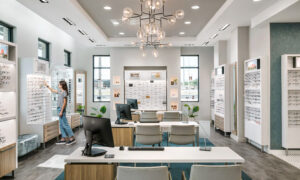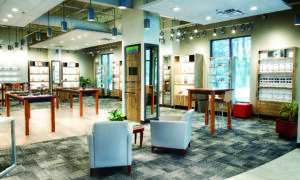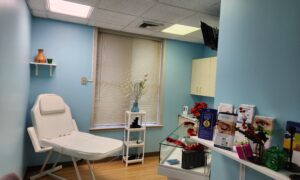Dec. 9, 2015
Andrew Fader,directorof marketing atEye Designs, demonstrates how new approaches to exam room design can enhance doctor-patient interaction, ease physical strain, and also pre-set the patient to purchase. Heshows how design facilitatesface-to-face engagement with the patient and provides efficient, easy access to EHR and supplies like trial lenses and eyedrops.
Be Face-to-Face withYour Patient
Design Can Help You Dispense from the Chair
Optometrists spend eight to 10 hours a day in their exam lanes, so the design of the exam lane mustaccommodate all of their varied needs, Andrew Fader, director of marketing at Eye Designs says. “Doctors deal with muscle strain and fatigue,” he notes, “and they also need to engage their patientto share the products and services they have to offer.”
Eye Designs has designed specific desk and exam lane configurations thatalleviate muscle strain and fatigue. At the same time, good design allows the doctor to engage with the patient. “Never turn your back to your patient,” Fader stresses. “Part ofengaging the patient is to make surethe doctor is positioned at the right angle to the patient.”
That way, thedoctor has access to patient records and histories through a computer monitor andalso is within arm’s length of the patient at all times.The doctor also can easily access supplies like trial lenses, diagnostic equipment and patient literature and information.
“Having access to all of these elements in the exam lane–the trial lenses, their diagnostic equipment–is something the doctors have asked us to be able to solve,” says Fader. “We’ve been able to create an exam lane that fills their needs from a form and function standpoint.”
“Design solves problems,” says Andrew Fader, director of marketing atEye Designs. “You need to keep that in mind, especially when you design your own exam lane.”
Good design can help ODs in one critical area, dispensing from the chair.This is achieved,Fader explains, bybringing some of the optical elements into the exam lanewhere new product offerings or task-specific eyecare can be showcased in a small fame board. “The key isbeing able to share with a patient interesting things that are new and exciting in the world of eyecare,”he says.
Thedoctor can show patients new frames that are styled for particular sports or activities, ordemonstrate features ofnew lens treatments. “This sets up a patient to ask questions when go into the optical area,” he notes.
Eye Designsalso has removed surface clutter byproviding handy shelving where critical supplies are easily accessed. “Drops and other supplies are no longer on the counter,” he says. “It gives that clean, clinical-looking environment that patients are expecting.”
Eye Designs offers a products and services board that lets patients know all the professional services you offer, from basic eye exams to more specifictreatments for dry eye, low vision, vision therapy, and the sale of neutraceuticals.
Fader advises OD to look critically at selectingan exam chair with ergonomic advantages. Along with the traditional round stool, doctors can opt for a saddle design, some with a back rest. “Please take the time to sit in various chairs before you make the final decision,” he urges.
.
Andrew Fader isdirector of marketing atEye Designs. To reach him: http://www.eyedesigns.com/contact.html



























